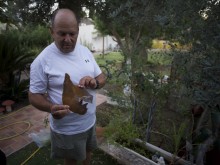Washington Post Ventures from Gaza to Cover Israel

News coverage of Operation Protective Edge mainly focused on casualties in the Gaza Strip, missiles launched at Israel and tunnels built by Hamas. There was comparatively little attention to the lives and hardships of Israelis, especially those who resided close to Gaza. So The Washington Post’s feature “I want to come back but, I’m afraid” (Aug. 14, 2014) was a noteworthy gesture toward balance.
The article commented that “[f[or the past month, ‘frontline communities’ such as Nahal Oz and a neighboring kibbutz, Kfar Aza, resembled ghost towns. Most residents fled what had become a combat zone, with Israeli artillery whooshing above them and Gaza rockets flying the other way, sometimes landing on rooftops or in gardens and schoolhouses.”
After Hamas took over the Gaza Strip in 2006, the southern Israeli town of Sderot and nearby kibbutzim have endured a rain of mortars and rockets that was under-reported by news media. Despite Israel’s complete withdrawal from Gaza in 2005, Palestinian complaints of “Israeli occupation” and Israel’s “siege” (a partial blockade aimed at limiting importation of material useful to Hamas and other terrorist groups) tended to draw the bulk of news reporting.
Without better balanced coverage, audiences don’t learn what life has been like on the Israeli side of the armistice line or the reasons for military operations conducted by Israel. (CAMERA has noted previous examples of more comprehensive coverage such as “Exhibit A: USA Today’s Well-Balanced Gaza Reporting”, July 15, 2014).
The Post ’s feature helped make real to readers the experiences of Israelis near Gaza. “People are so tired of living as refugees in their own country,” said Noam Stahl, 47, a plastics consultant and resident of Kfar Aza who was born and raised in the kibbutz.
The Post showed how Palestinian terror attacks affected the residents of Israel’s south wherever they were in their own country:
“Residents patiently answer questions about why they don’t move somewhere safer, as if it were so obvious it needs no explanation. Where in Israel is safe?
“‘In Tel Aviv, five years ago, people were afraid if they got on a bus it would explode,’ Stahl said. ‘Jerusalem was the same. At Kiryat Shmona in the north, for 15 years they had Katyusha rockets come at them from Lebanon. If I decide it’s no longer safe to live here, if I take my family and move elsewhere in Israel, who can guarantee we won’t be the target of a terrorist attack in our new home?’”
Stahl depicts Israel’s situation as it is. Israel bashers sometimes falsely describe the Gaza Strip as an “open air prison”. Such loaded language would not accurately describe Israel but the Jewish State is surrounded by countries and terrorist groups who have been seeking its destruction and since its inception in 1948. Perhaps more media attention to this enduring hostility and its effects on Israelis, less uncritical attention to Palestinian grievances and claims of Israeli oppression would help readers understand the conflict.
The Post’s “I want to comeback, but I’m afraid,” accurately described the situation for many residents of southern Israel . In doing so it informed readers of another side to the Arab-Israeli conflict—better, the Arab-Islamic conflict with Israel—too little discussed: the impact on Israelis. Other media outlets should take note. — Ziv Kaufman
More from SNAPSHOTS
Mahmoud Abbas’ Diatribe Threatening Israel Included Bogus Canaanite Claim
September 10, 2019
Palestinian Authority President Mahmoud Abbas’ recent anti-Israel diatribe that aired on PA TV was monitored and translated by Palestinian Media Watch (PMW). Excerpt: "I say to [Israel]: Every stone you have built on our land [...]
CNN Calls House’s Unifying Anti-BDS Vote ‘Divisive’
July 24, 2019
Yesterday, in an overwhelming vote of bipartisan support, the House of Representatives voted 398 to 17 to adopt a resolution opposing the anti-Israel BDS (boycott, divest, sanctions) campaign. Yet, CNN's headline casts the unifying vote [...]
NY Times Cites Poll, Hides Palestinian Support for Violence
July 9, 2019
The New York Times has struggled to accurately describe polls this year. In January, editor Jonathan Weisman misrepresented Pew polling data to describe a nonexistent surge in Israeli support for the United States under President [...]
CNN’s Zakaria Indulges Palestinian Propagandist Hanan Ashrawi
June 9, 2019
Fareed Zakaria’s weekly Cable News Network (CNN) program (grandiosely named “Global Public Square”) June 9 broadcast included a discussion of the current U.S. Middle East peace plan with guests Hanan Ashrawi (Palestinian Authority official) and [...]
In Robert Bernstein Obit, AFP Inappropriately References His Judaism
May 29, 2019
Robert Bernstein (Courtesy the New Press) In its obituary yesterday for American publisher Robert Bernstein, Agence France Presse inserted an inappropriate reference to the Human Rights Watch founder who later turned on the organization due [...]


